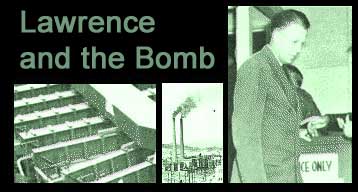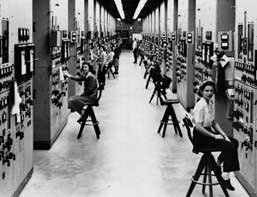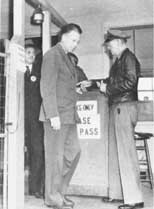

A few months before the Second World War started in Europe, the physics world was shaken by a discovery that would change Ernest Lawrence's life. German scientists reported that the uranium nucleus, when hit by a neutron, splits into two smaller nuclei—nuclear fission. Unlike the earlier splitting off of small pieces of atoms, fission released some of the huge store of energy bound in the nucleus. When the news reached the United States, staff in Lawrence's Radiation Laboratory bombarded uranium with neutrons and confirmed that they had missed another major discovery. Like many physicists, Lawrence sensed the tremendous possibilities of a nuclear chain reaction. |
"We are trying to find out whether neutrons are generally given off in the splitting of uranium; and if so, prospects for useful nuclear energy become very real!"—Lawrence to John Cockcroft; February 9, 1939 |
|
|
|
||||
| |
"I can still recall the expression in his eyes as he sat there with his mouth half open...He hesitated only a moment. ‘If you tell me this is my job, I'll do it.'"—Arthur Compton on Lawrence's commitment to a bomb project. |
|
 Early view of the Oak Ridge facility. |
|
 Women employees at Oak Ridge. |
|||
 Lawrence challenged at a checkpoint. |
|
|
"We had more trouble with Ernest Lawrence about personnel than any four other people put together."—Testimony of the chief security officer of the Manhattan Project. |
|
|
The pace and stress of the work taxed even Lawrence's abundant reservoirs of energy and enthusiasm, and plagued him with frequent respiratory infections. The increasing integration of science with military plans added to his responsibilities. As the atomic bomb project neared completion in the spring of 1945, Lawrence was appointed, along with Oppenheimer, Compton, and Enrico Fermi, to a "Scientific Panel." The panel advised the Secretary of War on postwar atomic energy policy and, more immediately, on the military use of atomic bombs. The war against Germany was ending and, to the surprise of Manhattan Project scientists, the Germans had not even come close to developing nuclear weapons. But the war against Japan ground on horribly. Lawrence suggested demonstrating an atomic bomb in front of Japanese representatives before using one against a city. His colleagues raised objections. The demonstration bomb might be a dud; the Japanese might shoot down the delivery plane, or herd American prisoners into the test area; and a demonstration seemed unlikely to convince the Japanese to surrender. Lawrence conceded, and the Panel unanimously recommended that the bomb be dropped without warning upon a war plant surrounded by workers' homes. (This was before the spectacular Trinity test, and the Panel scarcely grasped how a bomb could level an entire city.) The Panel also recommended that the U.S. notify its allies, including the Soviet Union, before using an atomic bomb. |
||
"In view of the fact that two bombs ended the war, I am inclined to feel [the Committee] made the right decision. Surely many more lives were saved by shortening the war than were sacrificed as a result of the bombs."—Lawrence to Karl Darrow and Lewis Akeley, August 1945 |
Lawrence witnessed the Trinity test of the first atomic bomb on July 16, 1945. Unlike some, Lawrence felt no remorse or dread after the test, but rather relief that the device worked. He suffered no moral anguish after the bombings of Hiroshima and Nagasaki in August. In his view, although one might regret the necessity of its use, the bomb had helped end the war with its bloodshed and suffering, and might help prevent future wars. But Lawrence did join his colleagues on the Scientific Panel that September when they opposed, on moral grounds, the pursuit of a "Superbomb." The hydrogen or fusion bomb, a thousand times mightier than a fission bomb, seemed more destructive than any reason could justify. |